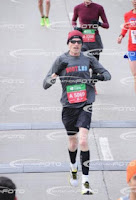I spent last week in Palm Springs doing some pretty serious pool relaxing as well as some hill work. On Sunday, my brother and I took the tramway up from the hot desert valley (it was 90 degrees) and hiked in mountain snow where the temps were in the 40s. Up on top, the air was pretty thin - we started at 8,300 feet and ascended to about 9,000 feet. The footing was not ideal as the snow was slippery. Most of the people we passed were either wearing snowshoes or skis!
 |
| Spring hiking near Palm Springs |
On Thursday, I actually ran up a "mountain" trail near downtown Palm Springs for three miles.
Despite the inclines, I felt really good and didn't get winded. It was so much fun and the views were spectacular, I had to fight the urge to go up again when I was finished!
Since there is no such thing as a truly flat street in PS, I saved my 20% speedwork for the downhill portions and was cruising pretty well - between a 6:00/mile and 6:20/mile in one mile intervals (with more than a little gravity assist).
 |
| Trail running in the mountains |
 |
| Elevation chart of Thursday's Mountain trail run |
Oh yeah, in addition to the 50 vacation miles I ran/hiked, I also had a lot of time to chill in the pool and try out my underwater camera.
 |
| Underwater in PS |
I now know I have decent endurance and can go uphill pretty well, so what should my strategy be on the flat Shuffle Course? I came up with this pace strategy off of the top of my head:
6:30, 6:10, 6:10, 6:00, 5:55 = 30:45
I like going out slowly for the first mile (as I may have mentioned in my last post). Even though my goal will be a minute and a half slower than my PR time last year, I am hoping if I feel good after mile three, I can always speed up and try and set a 2nd fastest PR of a sub 30:35.
In addition to being pumped for the race, I also scored a pass to the VIP tent, so it'll be a fun time regardless of what happens!
Anyone else shuffling?




